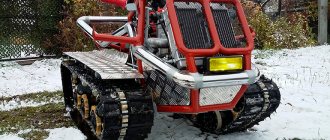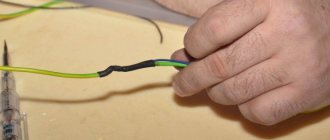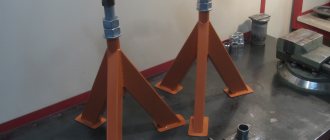The capabilities of a semi-automatic welding machine are significantly higher than those of a machine designed for manual arc welding. A semi-automatic machine can weld much thinner metal.
The use of a special welding wire allows you to work with non-ferrous metals, and the use of shielding gas provides a weld of higher quality. Considering these circumstances, the desire to add such a device to your home workshop is understandable.
How does a semi-automatic welding machine work?
The homemade device operates on the same principle as standard equipment. However, instead of electrodes, filler wire is used here. It is fed into the weld pool automatically using a special device. Due to the continuous operation of the mechanism, a melting zone is formed, allowing you to quickly connect 2 elements.
A transformer or inverter is included in the electrical circuit of a homemade semiautomatic device as a current source. An electric arc is formed on a pistol-type torch. The filler wire is fed through a rubberized hose. At the same time, gas flows through the channel.
The operating principle of a homemade welding machine is simple and the performance is high. The seam has a uniform surface and is characterized by increased strength. A homemade device is used for welding low-carbon steel and non-ferrous metals.
Additional settings for a semi-automatic welding device
In addition to primitive devices, there are schemes of advanced welding systems with an expanded set of functions. They have several additional features. Among them is the inductance setting.
Even budget semi-automatic models support changing this parameter, which is required to adjust the rigidity of the arc and change the characteristics of the weld. With low inductance, the temperature of the working element and the melting depth decrease. This leads to the appearance of a convex seam. Using this setting, you can connect thin parts and materials that are sensitive to intense heat.
At maximum inductance, the melting temperature increases and the bath becomes excessively liquid. The bead of such a seam becomes smooth and has no bulges. Using this mode, you can melt thick metal and carry out work in corner joints.
There are advanced welding systems with an expanded range of functions.
The next useful setting is changing the operating speed. Factory models have a High/Low marking, which is intended for more precise adjustment of the wire feed speed. Every semi-automatic device has a similar regulator, but if a home-made device supports working with consumables with a thickness of 0.6-1.4 mm, the boundary marks will be different.
When using thin wire, the toggle switch should be set to the High position, which will cause the wire to feed faster. For thick solder, select the Low position.
Semiautomatic from inverter
To make welding equipment from an inverter, you will need means of supplying current and filler material, and a torch that forms a protective gas environment. It is connected to a cylinder connected to the device with a hose.
When using some types of filler wire, it is possible to dispense with gas supply.
A pistol grip with a button serves as an electrode holder. The wire moves along the channel of the rubberized sleeve connecting the burner to the apparatus. The inverter unit must maintain a constant output voltage.
Tools and consumables
To assemble the device with your own hands, you will need the following materials and accessories:
- inverter with an output current of at least 150 A;
- a feeding mechanism that smoothly feeds the wire into the welded joint;
- a gas burner that melts the edges of metal parts;
- hose for supplying gas to the treated area;
- reel with consumables;
- an electronic device that controls the functions of the unit;
- Semi-automatic welding diagram.
We recommend reading: How to choose gas for welding
About the process of creating a semi-automatic machine
The finished inverter requires modification. The transformer included in the design is wrapped in thermal paper and copper wire. A core that is too thin cannot be used. During welding, it heats up, causing the machine to turn off.
The secondary winding of the transformer is protected with 3 layers of sheet metal. Soldering the ends increases current conductivity. The power source for a semi-automatic machine can be made from a ready-made welding inverter. It is connected to a separate housing containing the remaining elements.
Creating a wire feeder
This block is needed to uniformly introduce consumables into the weld pool. The wire is selected taking into account the type of metals being connected and the result of the work. The feed mechanism must adapt to any type and size of consumables. The finished device is purchased at an electrical goods store.
It is allowed to make a unit with your own hands from the following improvised means:
- motor from car wipers;
- pressure shaft with spring;
- 3 bearings;
- metal plates 1 cm wide.
All parts are installed on a 5 mm thick textolite stand. The wire is inserted between the shaft and the bearing. The point where the filler material is discharged is compared with the fastening of the end of the hose used for gas inlet.
The wire is wound onto the reel evenly, the strength of the welded joints depends on this. The coil is placed on a support and secured. During operation, the wire unwinds and enters the seam. This mechanism facilitates and speeds up the welding process.
Burner assembly diagram
This element is used to form a welded joint in a gas environment. It lasts for about a year and is classified as a consumable item. The operating principle of different burners is the same. The types differ in maximum heating temperature, power, and method of gas supply.
According to the description, the design of the unit includes the following parts:
- support with handle;
- nozzle;
- fasteners;
- tip;
- sleeve.
The elements of the device overheat during welding. The conductive tip and nozzle are most negatively affected. Their service life depends on the material they are made of. Cheaper options are made from copper, while more expensive ones are made from tungsten. On average, the handpiece lasts 200 hours.
The handle is made from fire-resistant insulating materials that protect the welder from electric shock. A gas supply hose 3-7 m long is connected to this part.
The burner should be small in size and weight. To make it yourself, use a plug connector. It is housed in a durable plastic case. To ignite the arc, the wire is brought out beyond the edge of the nozzle by 10-15 cm. Wire feeding begins by pressing the button on the handle, which the welder holds in his hands.
We recommend reading Instructions for semi-automatic cooking
Power connection
An important stage in converting an inverter into a semiautomatic device is installing a control element. He is also responsible for maintaining and converting current. The power cable is connected to the gas supply and wire extraction valve. To do this, install a welding inverter with a rectifier.
Communication between the engine and the rest of the unit components is provided by a 12 V intermediate automatic relay.
Final assembly of the unit
To manufacture the device, perform the following steps:
- Connect the inverter to the power supply and control units.
- Fill the feeder with wire and evaluate the uniformity of its distribution.
- Connect the burner to a hose connected to the cylinder. Turn on the inverter and check the gas supply. The wire begins to be drawn out into the weld pool after 1-2 seconds. The consumable material is supplied into a protective environment, which eliminates oxidation.
- Install input converters on radiators.
- A temperature sensor is installed in the hottest area of the inverter. It turns off the system when it overheats.
- Connect the power part of the electrical circuit to the control unit. Connect the inverter device to the network. The output current is measured, which should be more than 120 A. If the indicator is less, change the voltage.
Feed mechanism
Assembly should begin with the wire feed and tension mechanism. To assemble the mechanical part, you will have to use a pair of bearings (size 6202), an electric motor from car wipers (the smaller the motor, the better).
When choosing a motor, make sure that it rotates in one direction, and not “from side to side”. In addition, you will need to grind or find somewhere a roller with a diameter of 25 mm. This roller sits on top of the thread on the electric motor shaft. Each non-standard detail must be made by hand, fortunately, there is nothing complicated there.
The design of the feed mechanism consists of two plates on which the bearings are fixed, and a roller on the electric motor shaft, located in the middle. The plates are compressed and the bearings are pressed against the roller using a spring. From one bearing to the roller, a wire is drawn, threaded inside the “guides” on both sides of the rollers.
Installation is carried out on top of a textolite plate, the thickness of which is 5 mm. This is done so that the wire comes out where there will be a connector into which the welding sleeve attached to the front of the body is connected. We also install a reel on which the wire is wound on the PCB. We grind a shaft under the coil, which is installed at an angle of 90° to the plate, which has a thread on the edge to fix the latter.
The design of the semi-automatic do-it-yourself reference machine is simple and reliable, approximately the same as is used for industrial devices. The parts in the feed mechanism are designed for a regular coil, but welding will be carried out without gas; it’s good that welding wire is sold everywhere.
What should happen is shown at the top at the beginning of the article. Reinforcement of the computer case is carried out using two corners on those sides where the electronic part of the device is supposed to be installed. The rear wall of the case has a power supply and a device that regulates the frequency at which the electric motor rotates.
Semi-automatic transformer
If you have an unnecessary welding device of this type, you can assemble a working semi-automatic machine. A device with direct current and a rectifier does not require modification. A transformer operating with alternating voltage needs to be redone.
Required Tools
To assemble a welding machine at home, use the following devices:
- wire feed mechanism;
- welding current generation unit;
- power supply device;
- burner;
- support part;
- sleeves;
- clamps.
Selecting elements
Before you make the device yourself, you need to select the following components correctly:
- Power supply. To create this element, a transformer is used. The performance of the unit depends on this part.
- Frame. Use a box or box of the required size. It must be made of metal sheets or plastic. Transformers are installed in the housing and connected to the primary and secondary bobbins.
- Cooling system. During prolonged operation, the welding machine overheats. The easiest way to cool is to install fans. These devices are mounted in the side parts of the housing, opposite the transformer.
We recommend reading: How to cook using semi-automatic welding
Semi-automatic circuit
The drawing of a semi-automatic device includes an electronic unit, a high-frequency thyristor, and special rectifiers. The future device must have the optimal current strength, wire distribution speed, and voltage for the formation of a welded joint. To ensure these characteristics, a source of electric arc formation will be required.
Equipment preparation
To prepare the device for operation, you need to modify the following blocks:
- Three-phase transformer. It is converted into a direct current source. To do this, install filters and a diode bridge. The first one holds a stable arc, the second one straightens the voltage. Connecting a filter neutralizes voltage surges.
- Throttle element. It is obtained by wrapping an old transformer. A part from an old Soviet TV will do. The element has 2 coils located on a rounded core consisting of 2 parts. The structure is being dismantled. After this, the leads are removed. Copper wire is wound onto coils. The core parts are folded, and a 1.5 mm thick textolite attachment is installed between them. The coils are connected in series.
Types and classification
Based on their intended purpose, devices are divided into professional and household.
The first include:
- Burners for work related to metal processing: soldering, forging, welding.
- Devices for general construction, road work, roofing, wood burning, and removal of old paint.
- Technological equipment for various purposes. For example, drying chambers, food industry tools.
For household purposes, this includes a gas stove, nozzles for home stoves, heating boilers, and gas convectors.
Household devices include home workshop devices . This is where you most often find do-it-yourself burners, not only manufactured, but initially designed to perform specific tasks.
They are arranged according to two main schemes:
- injection or injection,
- with complete preliminary mixing of the working mixture, or ejection.
In the first type, air (or oxygen) is captured by the supplied gas stream. In the latter, the gas-air mixture is obtained in a preliminary chamber.
Power supply
Power for semi-automatic welding can come from a variety of sources, for example, the previously mentioned inverter, rectifier and transformer. Electric current is supplied to the welding machine from a three-phase network. It is recommended to use an inverter when making a homemade device.
If you follow the appropriate recommendations and choose high-quality components, you can get a high-quality, home-made device that will serve your household for many years and will become a real assistant when performing minor home repairs.











